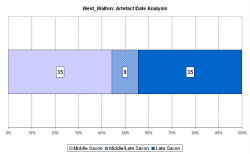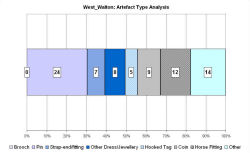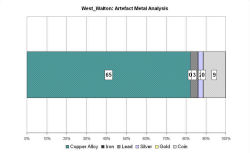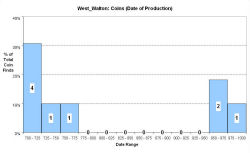Fingerprint charts for i) artefact date analysis, ii) artefact type analysis, iii) artefact metal analysis and iv) coins – date of production




Reference: Rogerson 2003
Archives:
http://ads.ahds.ac.uk/catalogue/search/fr.cfm?rcn=NMRMIC-5939
http://ads.ahds.ac.uk/catalogue/search/fr.cfm?rcn=EHNMR-659983
http://ads.ahds.ac.uk/catalogue/search/fr.cfm?rcn=NMR_NATINV-355071
The parish of West Walton is located in west Norfolk, on the border with Cambridgeshire, and 1.5km from the River Nene. Like other marshland parishes, much of the ground surface consists of clayey silt laid down in the Iron Age, and West Walton is the only known 'productive site' from the Norfolk fenland (Rogerson 2003, 118). The name may derive from the Old English meaning 'settlement by the wall'. Domesday records that West Walton possessed a fishery, a share in a church, numerous salt houses and a large number of sheep.
The Fenland Survey recovered no evidence of Early Anglo-Saxon activity in the parish which, at that time, was unfavourable marshland. However, scatters of Middle Saxon pottery around St Mary's church suggests 7th/8th-century activity. Field-walking demonstrated that finds were confined to areas of slightly higher ground formed by raised silt banks, or 'roddons'. Metal-detecting since 1987 has demonstrated that north of the church there is a well-defined area of finds, including a Late Saxon finger-ring, hooked tag and bridle cheek-piece along with a Middle Saxon pin and tweezers. The VASLE dataset is derived from the Norfolk HER, with some coin records from the EMC. The area is coterminous with the pottery distribution, but this 'productive site' is separated from pottery finds south of the church. The Sea Bank, a sea defence earthwork thought to be of Late Saxon origin runs c. 800m to the west (Rogerson 2003, 118-19).
Another area of Saxon settlement has been identified to the south of Ingleborough village. Excavations here in 1992 recorded substantial Middle Saxon and Late Saxon ditches full of domestic rubbish. Metal detecting has also retrieved a Late Saxon stirrup-strap mount and an 11th-century Ringerike-style mount. The presence of macrofossils also demonstrates that arable farming was carried out at this site.
The growth of Saxon sites can also be tracked by the pottery wares that have been identified. Most scatters of Saxon pottery include both Middle Saxon Ipswich Ware and Late Saxon Thetford Ware, suggesting some continuity of landscape utilisation.
Fingerprint charts for i) artefact date analysis, ii) artefact type analysis, iii) artefact metal analysis and iv) coins – date of production




© Internet Archaeology/Author(s)
URL: http://intarch.ac.uk/journal/issue25/2/4.4.62.html
Last updated: Tues Apr 21 2009